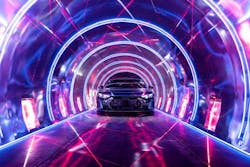This MTD exclusive was provided by Barry Neal, a senior partner and member of Roland Berger’s North American management team, and Neury Freitas, a principal at Roland Berger.
Independent tire dealers have weathered different technology developments during the automotive industry’s history. As vehicle design and components have continued to move from mechanical to electromechanical and electronic, tire dealers have remained nimble in order to serve vehicle needs.
At the same time, battery electric vehicles (BEVs), advanced driver assistance systems (ADAS) and vehicle connectivity represent large changes in vehicle technology, service requirements and capabilities.
Tire dealers must prepare for these changes in terms of training, investment and business processes, while aligning their investments to vehicle parc penetration and their individual business strategies.
The EV forecast
Forecasted electric vehicle (EV) demand has increased significantly post-COVID-19, with forecast estimates increasing from 21% of United States vehicle production to 29% by the year 2030. These forecast increases have been driven by the federal government, the success of new EV entrants and increased focus and launch targets from traditional original equipment manufacturers (OEMs).
Hybrid and plug-in hybrid vehicles sales are also expected to increase significantly from 5% today to 26% by 2030. Hybrids are anticipated to take a larger share of the market in the U.S. relative to Europe and China due to the more suburban population of the U.S., longer driving patterns, less use of regional public transit and less stringent regulation.
According to Roland Berger’s most recent Automotive Disruption Radar Survey, 50% of U.S. consumers who don’t currently own EVs would consider an EV for their next purchase.
At the same time, while vehicle range, price and charging access/speed have all improved, these elements remain the most significant impediments to EV uptake. Here’s a more detailed look:
Range. Vehicle ranges on 2022 base models vary from 100 miles (Mazda MX-30) to 520 miles (Lucid Air Dream Edition.) These range values are further limited by OEM guidance to retain batteries between 20% and 80% of charge to maximize battery life, plus extreme weather conditions, which can reduce range by up to 15%.
Price. Average transaction values for EVs in the U.S. in 2021 were $56,000 versus $46,000 for internal combustion engine (ICE) vehicles, excluding federal and state subsidies. EV sales are heavily over-indexed into higher price tag luxury sports cars and larger SUVs. And a high percentage of EVs sold today are part of households that have more than two vehicles. Battery cost is the key driver of higher pricing and limits customer acceptance in both the broader volume market segment, as well as used EV vehicle sales.
Charging access. Roland Berger’s Annual EV Charging Index scores the U.S. h in EV charging infrastructure maturity behind China, the Netherlands, Norway and France. U.S. public infrastructure density remains very low compared to other countries. The U.S. has only 100 to 200 charging stations per million people or 1.3 stations per 100 miles of roadway, compared with the Netherlands and Norway, for example, which have 1,000 to 2,000 charging stations per million people and 25 to 30 charging stations per 100 miles of roadway.
Despite limited public infrastructure, 83% of current U.S. EV owners surveyed were satisfied with their current charging experience. This reflects localized use cases - where 87% of charging is done at home - and the regionality of EV uptake in the U.S. REGIONALITY OF
The EV market
It’s not vehicle sales that impact the independent tire dealer, but the number of post-warranty vehicles out there. By 2035, BEVs will comprise just 15% of the entire vehicle parc, with only a 5% penetration in vehicles eight years and older.
EV uptake also is heavily concentrated, with 73% of EV sales centered in 10 states. California alone accounts for 43% of EV sales, due to the influence of vehicle emission requirements, less extreme weather conditions and more urban environments with shorter average commutes.
The good, the bad and the ugly
BEVs are estimated to require fewer visits and less total service and repair maintenance than ICE vehicles, excluding battery replacement, with an average of 1.8 visits per year versus 2.7 for an ICE. The Chevrolet Bolt maintenance calendar, for example, only calls for a tire rotation every 7,500 miles, a cabin air filter replacement every 22,500 miles and a coolant flush at 150,000 miles. These forecasts are based on mature technology and are driven primarily by the reduction in mechanical and wear components.
Even in the mid-term, the BEV impact is very different by aftermarket service channel. While quick lube and general service shops may see a downward risk of up to 40% of revenue per vehicle before new service categories and pricing adjustments, tire-heavy business models will see an overall balanced impact to revenue, with increased tire revenue compensating for lost sales in traditional service categories.
The good. There are several BEV categories that provide more frequent and higher-value service opportunities. The most critical of these - and positively for independent tire dealers - are tires. Instant torque and the additional weight of EV batteries create more significant tire wear than ICE vehicles and require heavier tires with more structural support.
Additionally, tread design and materials are key elements in achieving important BEV performance criteria, including range and low cabin noise. Range, as noted previously, is one of the most important BEV purchase criteria and tires with lower roll resistance are critical to achieving OE range certifications.
BEV passengers are also much more cognizant of tire road noise due to lack of engine “white noise.” The materials and tread that assist in achieving the above conditions generally also result in more expensive, higher-wear tire choices. Many BEV adopters are finding a need for new tires after as soon as 9,000 to 10,000 miles. With an average price increase of 10% per tire versus a comparable ICE car tire — with some offerings ranging up to a 40% premium — and faster wear, BEV tire sales create a significant opportunity.
Other key service opportunities on BEVs include chassis and suspension components, with a similar trade-off between higher wear and/or more robust components to balance the increased weight and forces and motor cooling. In addition, greater use of electronics and mechatronics in both propulsion and other body and chassis components creates higher part costs per repair order. Several new component categories also exist on BEVs — such as increased thermal management and battery coolant, battery checkups and repair — and drive motor/inverter repair and replacement.
The bad includes brakes and traditional battery replacement. Regenerative braking reduces pad and rotor wear. In addition, some components found in current model BEVs - such as the secondary, lower voltage battery and mild transmissions/drivebox, like that on the Porsche Taycan - are likely to be eliminated in most volume and even luxury applications in future generations.
The ugly includes many regular maintenance items, such as lubricants, engine and air filters, spark plugs, oxygen sensors, fuel management and timing and drive belts, which are eliminated on BEVs. A comparison between the Volkswagen Golf and Chevy Bolt BEV, for example, highlights that 79% of the 173 moving and wear components in the Golf are not present in the Bolt.
Service requirements
The investments required to fully service BEVs are significant. New vehicle dealers investing in the ability to service BEVs are typically investing a minimum of $250,000, not including technician training. These costs cover EV charging, including hardware, permits and labor; required infrastructure, such as transformers, excavation and labor; shop tools, including the battery lift and drive unit cradle; and related improvements and operating costs.
In addition, conducting high voltage battery service requires tying up a second bay to work on the extracted battery for most models, along with higher service time variability due to parts availability and service frequency/comfort. Even excluding technician training investments and time, 50% of new vehicle dealers will not see enough EV service to recover their investments within three years until 2026.
What to do now
Given the disparity in regional density and the low presence of BEVs in the overall vehicle parc, independent tire dealers need to determine whether to be a regional champion, who actively captures the lion’s share of limited BEV activity in his or her area; a fast follower; or simply wait on the sidelines.
Similar to the historic expansions of European and Asian vehicles into the U.S. vehicle parc, opportunities will exist for dealers to capture an above-market share of BEV service, utilizing a combination of aggressive marketing and early investments, as high rates of tire wear will create opportunities.
Fast followers need to be ready to pursue traditional maintenance opportunities as they expand, but may leverage referral networks for higher investment and training items such as complete battery removal and repair in the mid-term, similar to ADAS calibration.
Barry Neal is a senior partner and member of Roland Berger’s North American management team. Neury Freitas is a principal at Roland Berger. Contact Neal at [email protected] and contact Freitas at [email protected]



